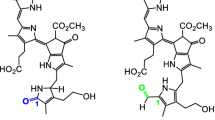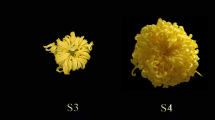Abstract
Here we describe the detection and identification of a yellow chlorophyll catabolite (Cj-YCC) in fresh extracts of senescent leaves of Cercidiphyllum japonicum. In addition, we report its partial synthesis by oxidation of Cj-NCC-1, the major (colourless) “nonfluorescent” chlorophyll catabolite (NCC) found in degreened leaves of C. japonicum. The spectroscopic analysis and structural characterization indicated Cj-YCC to be a simple dehydrogenation product of Cj-NCC-1 (by formal removal of a hydrogen atom at the C(20)- and C(1)-positions). Indeed, NCCs are easily oxidized and were first called “rusty pigments”, as they had a tendency to turn brown upon storage on a dry silica gel plate. The yellow tetrapyrroleCj-YCC may thus come about by oxidation of Cj-NCC-1 in the leaves. Its presence in the yellow leaves of a deciduous tree provides the first evidence for the contribution of a coloured chlorophyll catabolite to the fall colours.
Similar content being viewed by others
References
C. R. Bell, and A. H. Lindsey, Fall Colors and Woodland Harvests, Laurel Hill Press, Chapel Hill, USA, 1990.
S. B. Brown, J. D. Houghton, and G. A. F. Hendry, in Chlorophylls, ed. H. Scheer, CRP-Press, Boca Raton, USA, 1991, pp. 465–489.
P. Matile, Senescence in Plants and Its Importance for Nitrogen-Metabolism, Chimia, 1987, 41, 376–381.
B. Kräutler, B. Jaun, K. Bortlik, M. Schellenberg and P. Matile, On the Enigma of Chlorophyll Degradation - the Constitution of a Secoporphinoid Catabolite, Angew. Chem., Int. Ed., 1991, 30, 1315–1318.
P. Matile, S. Hörtensteiner, H. Thomas, B. Kräutler, Chlorophyll breakdown in senescent leaves, Plant Physiol., 1996, 112, 1403–1409.
B. Kräutler and P. Matile, Solving the riddle of chlorophyll breakdown, Acc. Chem. Res., 1999, 32, 35–43.
B. Kräutler, and S. Hörtensteiner, in Chlorophylls and Bacteriochlorophylls, ed. B. Grimm, R. Porra, W. Rüdiger and H. Scheer, Springer, Dordrecht, The Netherlands, 2006, pp. 237–260.
B. Kräutler, Chlorophyll breakdown and chlorophyll catabolites in leaves and fruit, Photochem. Photobiol. Sci., 2008, 7, 1114–1120.
P. Matile, in Regulation of Photosynthesis, ed. E.-M. Aro and B. Andersson, Kluwer Academic Publishers, Dordrecht, The Netherlands, 2001, pp. 277–296.
S. Hörtensteiner, Chlorophyll Degradation During Senescence, Annu. Rev. Plant Biol., 2006, 57, 55–77.
T. Müller, M. Ulrich, K. H. Ongania, B. Kräutler, Colorless Tetrapyrrolic Chlorophyll Catabolites Found in Ripening Fruit Are Effective Antioxidants, Angew. Chem., Int. Ed., 2007, 46, 8699–8702.
C. Curty and N. Engel, Chlorophyll catabolism. 9. Detection, isolation and structure elucidation of a chlorophyll a catabolite from autumnal senescent leaves of Cercidiphyllum japonicum, , Phytochemistry, 1996, 42, 1531–1536.
M. Oberhuber, J. Berghold, K. Breuker, S. Hörtensteiner, B. Kräutler, Breakdown of chlorophyll: A nonenzymatic reaction accounts for the formation of the colorless “nonfluorescent” chlorophyll catabolites, Proc. Natl. Acad. Sci. USA, 2003, 100, 6910–6915.
K. Bortlik, C. Peisker and P. Matile, A Novel Type of Chlorophyll Catabolite in Senescent Barley Leaves, J. Plant Physiol., 1990, 136, 161–165.
H. Falk, Chemistry of Linear Oligopyrroles and Bile Pigments, Springer Verlag, Wien, 1989.
H. Kessler, M. Gehrke and C. Griesinger, Two-Dimensional NMR-Spectroscopy - Background and Overview of the Experiments, Angew. Chem. Int. Ed., 1988, 27, 490–536.
F. G. Losey and N. Engel, Isolation and characterization of a urobilinogenoidic chlorophyll catabolite from Hordeum vulgare, J. Biol. Chem., 2001, 276, 8643–8647.
D. E. Baranano, M. Rao, C. D. Ferris and S. H. Snyder, Biliverdin reductase: A major physiologic cytoprotectant, Proc. Natl. Acad. Sci. USA, 2002, 99, 16093–16098.
H. Scheer, in Chlorophylls and Bacteriochlorophylls. Biochemistry, Biophysics, Functions and Applications, ed. B. Grimm, R. J. Porra, W. Rüdiger and H. Scheer, Springer, Dordrecht, 2006, pp. 1–26.
B. Kräutler, in Progress in the Chemistry of Organic Natural Products, ed. W. Herz, H. Falk, G. W. Kirny, R. E. Moore and C. Tann, Springer Verlag, Wien, 2008.
Author information
Authors and Affiliations
Corresponding author
Additional information
This paper was published as part of the themed issue in honour of Nicholas Turro.
Rights and permissions
About this article
Cite this article
Moser, S., Ulrich, M., Müller, T. et al. A yellow chlorophyll catabolite is a pigment of the fall colours. Photochem Photobiol Sci 7, 1577–1581 (2008). https://doi.org/10.1039/b813558d
Received:
Accepted:
Published:
Issue Date:
DOI: https://doi.org/10.1039/b813558d




